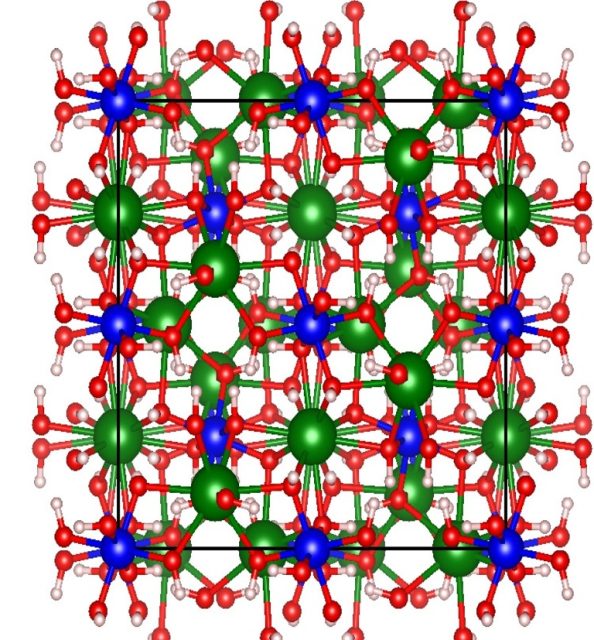The promise of katoite
Picture this: Your home’s walls don’t just keep out the rain—they soak up warmth from the sun during the day, slowly release it to keep you cosy at night, and even convert some of that heat into a trickle of electricity to power your lights or charge your phone. This isn’t science fiction; it’s the exciting potential unlocked by recent research on a mineral called katoite, which forms naturally in a special type of cement. In a new study 1, scientists used advanced computer simulations to show how katoite could transform everyday building materials into active energy systems. Their work points to a future where buildings help fight climate change by storing and generating energy efficiently.

Katoite
Cement is a powdery mix that hardens when mixed with water through a reaction called hydration. Most common cements, like Portland cement, contain minerals based on calcium and silicon. But calcium aluminate cement—a tougher variety often used in high-heat environments like furnaces or chemical plants—creates katoite instead. Katoite’s chemical formula is Ca₃Al₂(OH)₁₂, meaning it’s made of calcium (Ca), aluminium (Al), oxygen (O), and hydrogen (H) atoms arranged in a sturdy, cube-like crystal structure. Think of it as a microscopic framework where aluminium atoms sit in octahedrons (eight-sided shapes) surrounded by oxygen and hydrogen groups, with calcium atoms filling the spaces in between. This setup makes katoite remarkably stable; it doesn’t break down until temperatures reach 250–275°C, far hotter than what ordinary cement can handle without cracking or weakening.

Why does this matter? Buildings account for about 40% of global energy use, mostly for heating and cooling, according to reliable sources like the International Energy Agency. If we could make the materials in walls, floors, and foundations store heat or turn it into electricity, we could cut down on fossil fuels and make structures more sustainable. Consequently, the researchers zeroed in on two properties: thermal energy storage and thermoelectricity.
Thermal energy storage and conductivity
Thermal energy storage is straightforward—it’s about how well a material can absorb heat when things get warm and release it when they cool down, without changing its form (like melting or reacting chemically). Key factors here are heat capacity and thermal conductivity. Heat capacity measures how much heat energy a gram of the material can hold for every kelvin it warms up—kind of like how a sponge holds water. Katoite shines here with a heat capacity of about 1.14 joules per gram per kelvin. That’s better than or equal to many other cement minerals, meaning it could help regulate indoor temperatures naturally, reducing the need for air conditioners or heaters.
Thermal conductivity, on the other hand, is how quickly heat travels through the material, measured in watts per meter per kelvin (W/mK). Too high, and heat escapes too fast; too low, and it doesn’t spread evenly. Katoite’s value is around 1.5 W/mK at room temperature, similar to regular concrete. This moderate level allows it to store heat effectively while letting it flow at a useful rate, making it ideal for applications like solar-heated walls that warm a room gradually.
So, in these respects, good and useful, but nothing really revolutionary.
Dope thermoelectricity
Now, for the really innovative part: thermoelectricity. This is the ability to convert heat directly into electricity without moving parts, like in some spacecraft power systems. It relies on the Seebeck effect, discovered in the 1800s: When one side of a material is hotter than the other, it creates a voltage difference that can drive an electric current. The efficiency depends on three things—the Seebeck coefficient (how much voltage per degree of temperature difference), electrical conductivity (how easily electrons flow), and thermal conductivity (which you want low to keep the heat gradient). Scientists combine these into a single score called the thermoelectric figure of merit, or ZT—a dimensionless number where higher is better. Top commercial materials, like bismuth telluride used in cooling devices, have ZT around 1 or more.
Pure katoite isn’t great at this naturally. It’s an electrical insulator, meaning electrons don’t move freely through it, so its ZT is tiny—about 0.00001 at 227°C (500 Kelvin). But the team didn’t stop there. They simulated “doping,” adding tiny amounts of other atoms to tweak the electron count. In n-type doping, you add extra electrons (like injecting more players into a game to speed things up); in p-type, you create “holes” where electrons are missing, which act like positive charges moving around.
The results were impressive. With n-type doping, ZT jumped to 0.31 at 500 K. For p-type, it hit 0.60—over 600,000 times better than undoped! While not yet matching the best lab-made thermoelectrics, this is really huge for a cheap, abundant material like cement. The simulations suggest practical ways to dope: Swap some aluminium atoms with magnesium, or tweak the hydroxyl (OH) groups. Importantly, katoite’s mechanical strength—its ability to withstand stress without breaking—matches or exceeds common cement minerals like portlandite (from Portland cement) or tobermorite (in some eco-friendly cements). So, doping wouldn’t make the material brittle.
A theoretical nice balance
There’s a trade-off, though. Qualities great for heat storage, like decent thermal conductivity, can hurt thermoelectric efficiency by letting heat equalize too quickly. Katoite strikes a nice balance: conductive enough to store and distribute heat, but not so much that it ruins electricity generation when doped.
To reach these conclusions, the researchers didn’t mix cement in a lab—they used powerful computer models based on quantum mechanics, specifically density functional theory (DFT). This simulates how atoms and electrons behave at the tiniest scales. They combined it with Boltzmann transport theory to predict heat and electron flow. To verify accuracy, they tested the models on related minerals like grossular (a garnet) and mayenite (another calcium aluminate), where predictions matched real experiments. This gave confidence in the katoite results.
What could this mean for the real world? Imagine “smart” concrete in buildings that captures daytime solar heat, stores it in walls, and releases it overnight—or generates small amounts of power from temperature differences between indoors and outdoors. Calcium aluminate cement is already used in tough spots like wastewater pipes or fire-resistant linings, so scaling up isn’t a stretch. It could lower energy bills, reduce carbon emissions, and make cities more resilient to extreme weather.
Of course, this is theoretical so far. The next steps, as the authors note, involve lab experiments: Synthesizing doped katoite, measuring its properties in real samples, and testing in mini-structures. Challenges remain, like ensuring doping is uniform and cost-effective. But in the authors’ view, doping katoite-based cements could lead to truly sustainable buildings that actively contribute to our energy needs.
Author: César Tomé López is a science writer and the editor of Mapping Ignorance
Disclaimer: Parts of this article may have been copied verbatim or almost verbatim from the referenced research paper/s.
References
- Ridwan O. Agbaoye , Andrés Ayuela & Jorge S. Dolado (2025) Design of improved thermoelectric and thermal energy storage properties of katoite, the stable hydration product of calcium aluminate cement Materials & Design doi: 10.1016/j.matdes.2025.114678 ↩